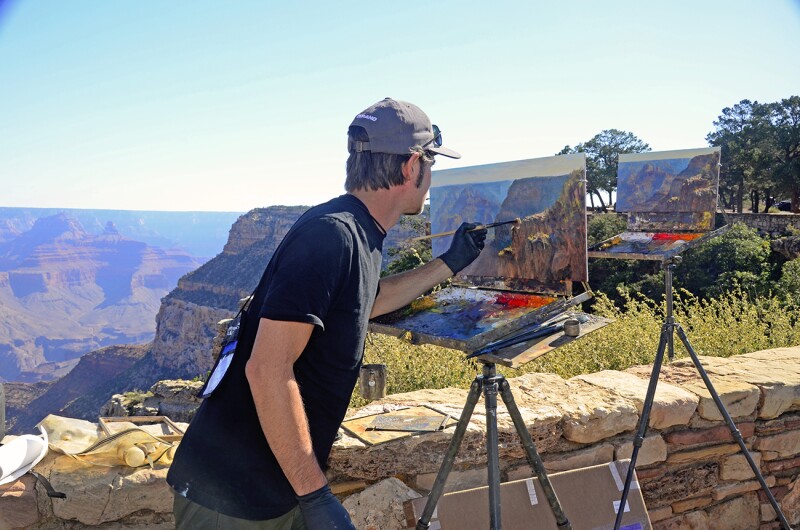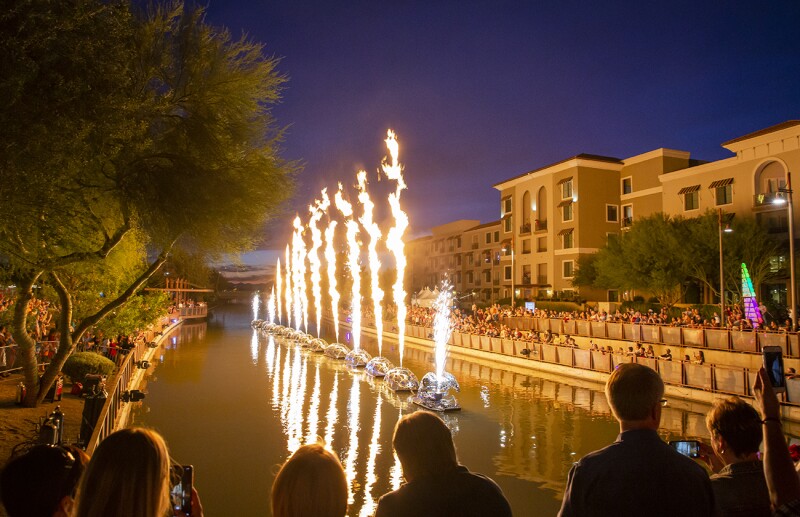After visiting the Grand Canyon for the first time in 1873, landscape artist Thomas Moran claimed, “Of all places on Earth, the great Canyon of Arizona is the most inspiring in its pictorial possibilities.” He returned numerous times to paint the natural wonder, but he wasn’t the first—or last—artist to be influenced by the grandeur of Arizona.
For centuries, creative types—from ancient native artisans to surrealists Dorothea Tanning and Max Ernst—have turned to Arizona’s landscape and culture for inspiration, then expressed it in their work, be it pottery, paintings, sculpture, or architecture. Today, Arizona’s artistic heritage provides a rich visual feast worthy of a road trip. Here are just a few places and events to add to your itinerary.
The Art Enclaves
Tanning and Ernst spent part of the 1940s and ’50s amid Sedona’s spectacular red rocks, when the town was a nascent art center. In the intervening years, Sedona has blossomed into a major art enclave, with more than 55 galleries exhibiting everything from traditional landscapes to contemporary works, a monthly 1st Fridays in the Galleries open-house event, the nonprofit Sedona Arts Center offering classes and exhibitions, a calendar full of art festivals, and a sizable public art collection.

The Scottsdale Museum of Contemporary Art is home to famous works like this piece by James Turrell.
Photo by Sean Deckert
Though it’s largely known as a resort community, Scottsdale is also an art town; internationally renowned artists like Fritz Scholder and Philip Curtis have even called it home. With more than 100 galleries, some 100 public artworks, and the Thursday evening downtown ArtWalk—a tradition since 1975—the city attracts as many art aficionados as golfers. Add to the mix several art festivals and two art museums—the Scottsdale Museum of Contemporary Art and Western Spirit: Scottsdale’s Museum of the West—and you have all tastes covered.
In 1948, landscape artist Dale Nichols started an art school in Tubac, a southern Arizona community founded in the 18th century as a Spanish presidio, giving rise to the town’s slogan, “where art and history meet.” There’s still an art school there, plus plenty of studios and galleries, numerous art festivals, and the Tubac Center of the Arts, a cultural hub known for art exhibits, film screenings, and concerts.
When their copper started running out in the 1950s, two small Arizona mining towns also reinvented themselves as art communities. On Cleopatra Hill in central Arizona, Jerome is now home to a dozen or so galleries and studios. It’s also the site of an evening art walk the first Saturday of the month, with a free shuttle bus that ferries visitors up and down steep streets. Farther south, Bisbee, a town that prides itself on its quirky, bohemian vibe, has galleries and craft boutiques lining its main streets. The Bisbee After 5 art walk on the second Saturday of the month is another popular draw, with more than 30 galleries, shops, and restaurants staying open late for visitors.
The Museums

The Heard Museum is known for its exhibits highlighting Arizona’s tribes and their art.
Courtesy of Heard Museum
Scottsdale isn’t the only Arizona city to lay claim to stellar museums. In nearby Phoenix, visitors can find two other world-class institutions. Founded in 1929, the Heard Museum devotes itself to American Indian culture through exhibits on Arizona’s tribes and their arts, as well as shows that spotlight contemporary artists, such as a recent installation of conceptual works by Canadian artist Maria Hupfield. Annual events like the hoop dance festival and Indian market also feature on the museum’s calendar.

Art fans won’t want to miss the blockbuster shows at the Phoenix Art Museum.
Courtesy of Phoenix Art Museum
Down Central Avenue, the Phoenix Art Museum is home to more than 19,000 works (including paintings by the “Magritte of the Old West,” Philip Curtis) and often hosts blockbuster exhibitions in its airy, modern digs. Look for an emphasis on American, Latin American, Western, and contemporary art, plus galleries devoted to fashion and photography—an Ansel Adams exhibit runs through early June.

The collection at the Tucson Museum of Art includes works of the American West.
Courtesy of Tucson Museum of Art
Another spot worth visiting is the Tucson Museum of Art, where a modern building anchors a courtyard surrounded by five historic homes, which house classrooms, a restaurant, a shop, and additional exhibition space. The museum’s collection includes modern art, as well as art of the American West, Latin America, and Europe. A special exhibit examining the legacy of legendary Arizona art dealer Elaine Horwitch, who championed contemporary Southwest artists, is up through June.
In the piney forests of Flagstaff, the Museum of Northern Arizona celebrates the region’s natural and cultural history and includes exhibitions that emphasize the work of contemporary American Indian artists. Founded in 1928, the museum is also known for its long-standing Hopi, Navajo, and Zuni festivals, held in spring and summer to showcase each tribe’s culture and art.
The Festivals
Get a little sunshine with your art by timing your Arizona visit to coincide with a festival. La Encantada Fine Art Festival kicks off the year in January, with 50 regional and national artists showing works at an outdoor shopping center near Tucson’s craggy Santa Catalina Mountains. In February, the Tubac Festival of the Arts, which has been around for more than six decades, welcomes some 200 visiting artists to exhibit their pieces throughout the town’s galleries, shops, and streets. And in March, the Scottsdale Arts Festival—which marks its 50th anniversary in 2020—draws crowds with works by more than 170 artists, plus live music, food, and hands-on activities for children.

During the Grand Canyon Celebration of Art, landscape artists gather for outdoor events in the national park.
Photo by Deb Weinkauff/Grand Canyon Conservancy
When things get hot in the desert, art crowds move north for Flagstaff Art in the Park, during which more than 100 Southwestern artists showcase their work over the Fourth of July and Labor Day holidays. In September, the Grand Canyon Celebration of Art fetes noted landscape artists, who participate in a show, sale, and outdoor events at the canyon’s edge, all within the national park.

Attend the Sedona Arts Festival to see works amid the red rocks.
Courtesy of Sedona Arts Festival
October is a good time to be back among the red rocks for the Sedona Arts Festival, which includes artist booths, local studio tours, and musical performances, as well as the Sedona Plein Air Festival, when 25 artists set up their easels outdoors to capture the area’s natural beauty. Also in October, some 125 artists and craftspeople gather for the Patagonia Fall Festival, held in a tree-shaded park.

The illuminated art installations at Canal Convergence look particularly good on Instagram.
Photo by Chris Loomis
In November, Scottsdale Public Art closes out the festival year with its annual Canal Convergence, complete with 10 straight evenings of interactive, illuminated, and Instagram-worthy art installations in and along the Arizona Canal, plus performances, workshops, and food.
The Architecture
When visiting Arizona, design and building buffs will want to make pilgrimages to some of the state’s architectural treasures, including touchstones of three important eras.
In central Arizona, Casa Grande Ruins National Monument preserves what remains of an impressive, multistory “big house,” built of caliche in the 1300s by the ancestral Sonoran Desert people. It’s thought to be one of the largest prehistoric structures in North America, although its original use remains a mystery.
Near Tucson, San Xavier del Bac is an exuberantly detailed Spanish church dating to the late 1700s. Built on a mission site established by Father Eusebio Kino in 1692, the church, with its gleaming white-plaster exterior and ornate religious frescoes, is open for tours, but still serves the surrounding Tohono O’odham community with daily masses.

Frank Lloyd Wright’s winter home is now a UNESCO World Heritage site.
Photo by Foskett Creative/Frank Lloyd Wright Foundation
Architect Frank Lloyd Wright looked to both these structures, as well as the desert landscape, when he began building Taliesin West, his winter home, studio, and architectural compound, out of native rock and redwood beams in 1937. Today, the Scottsdale compound is a UNESCO World Heritage site that’s open for tours. It also houses an architecture school, book store, and calendar full of public lectures, workshops, and performances.
>>Next: Plan Your Trip With AFAR’s Travel Guide to Arizona











